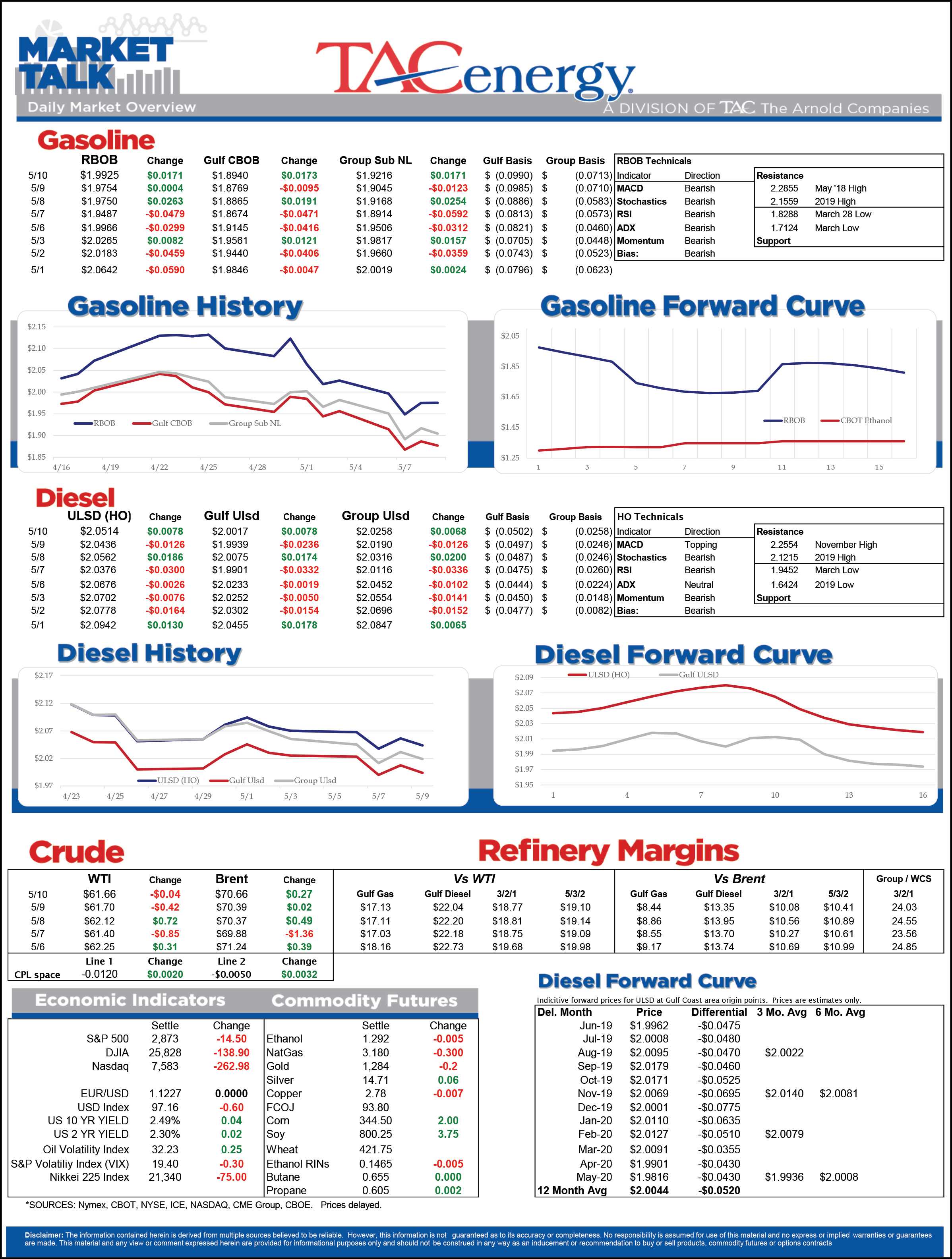Trade Teeter Totter Continues To Dominate

The trade teeter totter continues to dominate the action in futures markets this week as US/China negotiations are set to begin again today.
After an early round of selling, both energy and US stock prices seemed to find a floor Thursday following reports of a letter and potential phone conversation between the US and Chinese presidents, providing optimism that a deal to avoid another round of retaliatory tariffs could be struck. So far this morning equity markets are less enthused about those prospects with futures pointing to losses of a little less than 1% when trading begins, while energy futures are clinging to modest gains.
After being the weakest link in the Energy chain during the heavy selling early in the week, RBOB gasoline futures have been leading the increases since the DOE report Wednesday, apparently reacting to strong domestic demand estimates, a large decline in East Coast refinery runs, and tighter than normal total inventories. While the recent strength for gasoline is welcome news for refiners, markets on the other side of the world are flashing warning signs that the good times for gasoline margins may soon come to an end.
Late this afternoon we’ll get to see how money managers are reacting to the rollercoaster ride when the COT report is released. So far the resilience of money managers betting on higher prices has been enough to stave off a technical breakdown, but when they decide to head for the exits, all bets (in some cases literally) are off.
Winners and losers: The EIA published a note this morning estimating that 2018 was the most profitable year for oil producers since 2013, and yet this week we’ve already seen one producer file for bankruptcy and another lay the groundwork to do the same. With the world’s largest oil companies all pledging dramatic increases to their operations in US shale plays, it seems there could be more small producers who get squeezed out of business even with prices holding at profitable levels.
Good luck with that: Mexico’s president was not satisfied with bids to build a new refinery, so announced that the government would partner with Pemex on the $8 billion project. Considering Mexico’s current refineries are operating at less than half of their capacity due to issue with Pemex and the government, that project now looks like a long shot at best.
News & Views
View All
Energy Futures Are Caught Up In Headline Tug-O-War This Morning
Energy futures are caught up in headline tug-o-war this morning with Canadian oil production concerns and a positive US GDP report trying to push prices higher while sinking Chinese demand worries and Gaza ceasefire hopes are applying downward pressure. The latter two seem to be favored more so far this morning with WTI and Brent crude oil futures down ~45 cents per barrel, while gasoline and diesel prices are down about half a cent and two cents, respectively.
No news is good news? Chicago gasoline prices dropped nearly 30 cents yesterday, despite there not being any update on Exxon’s Joliet refinery after further damage was discovered Wednesday. Its tough to say if traders have realized the supply situation isn’t as bad as originally thought or if this historically volatile market is just being itself (aka ‘Chicago being Chicago’).
The rain isn’t letting up along the Texas Gulf Coast today and is forecasted to carry on through the weekend. While much of the greater Houston area is under flood watch, only two refineries are within the (more serious) flood warning area: Marathon’s Galveston Bay and Valero’s Texas City refineries. However, notification that more work is needed at Phillip’s 66 Borger refinery (up in the panhandle) is the only filing we’ve seen come through the TECQ, so far.
Premiums over the tariff on Colonial’s Line 1 (aka linespace value) returned to zero yesterday, and actually traded in the negatives, after its extended run of positive values atypical of this time of year. Line 1’s counterpart, Line 2, which carries distillates from Houston to Greensboro NC, has traded at a discount so far this year, due to the healthy, if not over-, supply of diesel along the eastern seaboard.
Click here to download a PDF of today's TACenergy Market Talk.

WTI And Brent Crude Oil Futures Are Trading ~$1.50 Per Barrel Lower In Pre-Market Trading
The across-the-board drawdown in national energy stockpiles, as reported by the Department of Energy yesterday, stoked bullish sentiment Wednesday and prompt month gasoline, diesel, and crude oil futures published gains on the day. Those gains are being given back this morning.
The surprise rate cut by the People’s Bank of China is being blamed for the selling we are seeing in energy markets this morning. While the interest rate drop in both short- and medium-term loans won’t likely affect energy prices outright, the concern lies in the overall economic health of the world’s second largest economy and crude oil consumer. Prompt month WTI and Brent crude oil futures are trading ~$1.50 per barrel lower in pre-market trading, gasoline and diesel are following suit, shaving off .0400-.0450 per gallon.
Chicagoland RBOB has maintained its 60-cent premium over New York prices through this morning and shows no sign of coming down any time soon. Quite the opposite in fact: the storm damage, which knocked Exxon Mobil’s Joliet refinery offline on 7/15, seems to be more extensive than initially thought, potentially extending the repair time and pushing back the expected return date.
There are three main refineries that feed the Chicago market, the impact from one of them shutting down abruptly can be seen in the charts derived from aforementioned data published by the DOE. Refinery throughput in PADD 2 dropped 183,000 barrels per day, driving gasoline stockpiles in the area down to a new 5-year seasonal low.
While it seems all is quiet on the Atlantic front (for now), America’s Refineryland is forecasted to receive non-stop rain and thunderstorms for the next four days. While it may not be as dramatic as a hurricane, flooding and power outages can shut down refineries, and cities for that matter, all the same, as we learned from Beryl.



